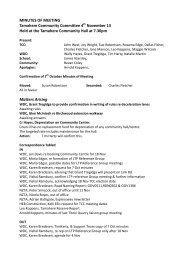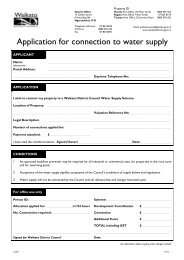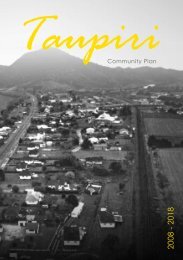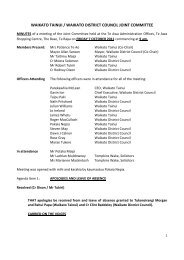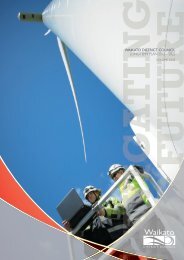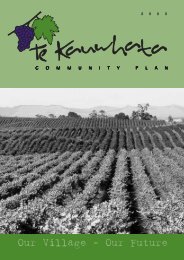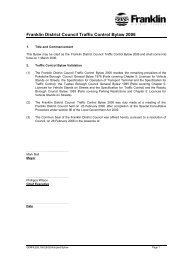1.2 Purpose of this waste assessment - Waikato District Council
1.2 Purpose of this waste assessment - Waikato District Council
1.2 Purpose of this waste assessment - Waikato District Council
- No tags were found...
Create successful ePaper yourself
Turn your PDF publications into a flip-book with our unique Google optimized e-Paper software.
Waste to landfillCommercial operator-controlled <strong>waste</strong> streamsTonnes perannum% <strong>of</strong> totalPrivate kerbside refuse collections 1,464 5%General <strong>waste</strong> 16,098 54%Total - Commercial operator-controlled <strong>waste</strong> to landfill 17,562 59%Total – <strong>waste</strong> to landfill 29,794 100%In total, close to 30,000 tonnes <strong>of</strong> <strong>waste</strong> are estimated to be disposed <strong>of</strong> to landfill from the <strong>Waikato</strong> districteach year.Of <strong>this</strong> total, the council controls about 41 per cent. This includes the council’s kerbside refuse collections and<strong>waste</strong> that passes through the council’s three transfer stations. The proportion <strong>of</strong> <strong>waste</strong> over which the councilhas direct control is important when planning <strong>waste</strong> minimisation services as different options are available tocouncil to mange those <strong>waste</strong> streams over which it has direct control.About 39 per cent <strong>of</strong> the <strong>waste</strong> being disposed <strong>of</strong> to landfill is from kerbside collections. These include thecouncil’s kerbside refuse collections, the council’s inorganic refuse collection, and private kerbside refusecollections.4.2.2 Diverted materials quantities for the <strong>Waikato</strong> districtThe data on council-controlled diverted materials in the table below is taken from council records. Estimates <strong>of</strong>commercial operator-controlled diverted materials are based on per capita data on diverted material generationgathered in other districts.In <strong>this</strong> analysis, ‘diverted materials’ includes only the council-controlled recycling systems (ie kerbside recyclingand transfer station drop-<strong>of</strong>fs) and ‘commodities’ (ie paper, kraft, glass, plastic and metal containers) collectedby commercial recyclers. No attempt has been made to quantify other diverted materials, such as:• Scrap metal• Concrete• Construction and demolition materials such as timber• Organic <strong>waste</strong> used for stock feed• Tyres• Second-hand goods• Timber processing <strong>waste</strong> used for hog fuel.Table 12: <strong>Waikato</strong> district diverted materialsDiverted materials<strong>Council</strong>-controlled diverted materialsTonnes perannum% <strong>of</strong> totalKerbside recycling collections and transfer station drop-<strong>of</strong>f recycling 6,989 T/annum 23%Green<strong>waste</strong> from transfer stations (Raglan only)Subtotal – <strong>Council</strong>-controlled diverted materials 4,320 62%Commercial operator-controlled diverted materials26



